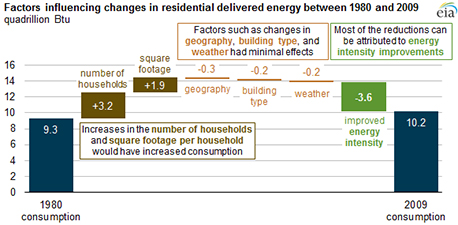The growth in residential energy use has slowed to below the rate of household growth, meaning that per-household energy consumption has decreased. Analysis of EIA’s Residential Energy Consumption Survey (RECS) conducted since 1980 shows how improvements in energy efficiency reduced energy intensity enough to offset more than 70 percent of the growth in both the number of households and the size of dwellings.
Between 1980 and 2009 (the most recent survey year), delivered energy used by U.S. households increased from 9.3 quadrillion British thermal units (quads) to 10.2 quads, an average growth of 0.3 percent per year. The change in delivered energy during this period can be broken into component factors, including number of households, structural changes, weather and energy intensity (measured here as consumption per square foot).
After adjusting for the effects of the other factors, 2009 energy intensity declined (improved) by about 37 percent compared with the level in 1980, meaning that without this change, households would have required another 3.6 quads of delivered energy in 2009. The effects of reduced energy intensity are significantly greater when considered in terms of primary energy use, which takes into account that, on average, nearly three units of energy from primary fuels such as coal, natural gas and nuclear fuel are used to generate one unit of electricity, which is a major part of energy use in households.
The gains from energy intensity improvements would have been even larger if it were not for consumer preferences for larger homes and increased adoption of home appliances and electronics. In this period, the average home size grew by about 20 percent. With increased square footage came adoption of more and larger devices such as more televisions with larger screens and new or expanding end uses such as computers, networking equipment and home entertainment devices.
Additional analysis of delivered energy consumption as well as separate sections for electricity and natural gas space heating are included in EIA’s report on Drivers of U.S. Household Energy Consumption.









